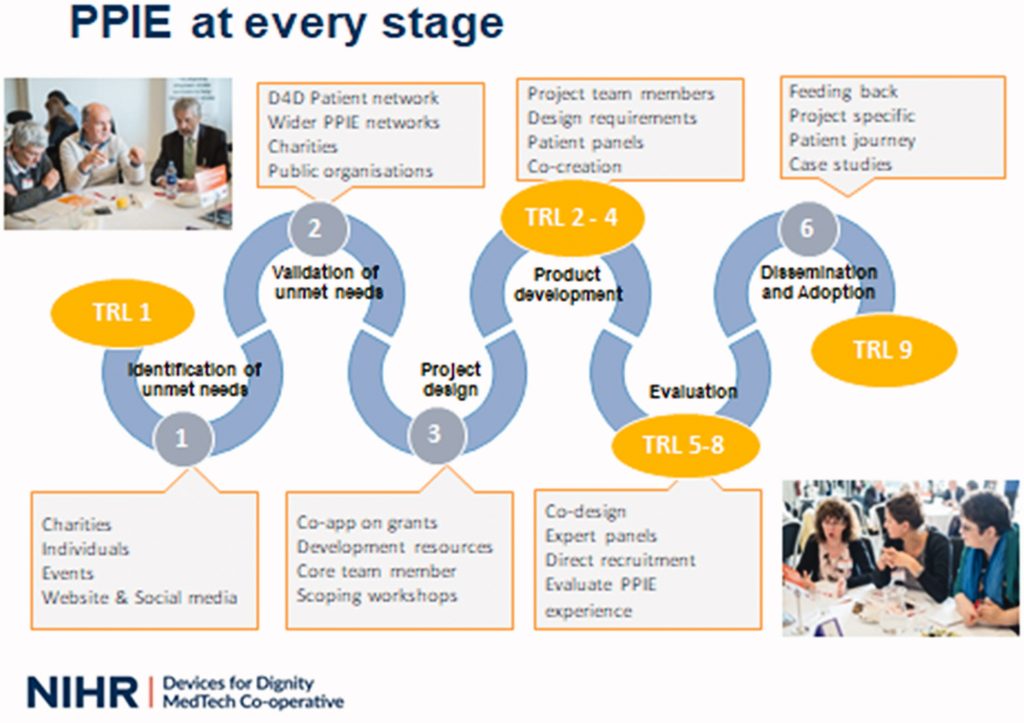This blog is based on an original research article. The views expressed are those of the author(s) and reviewer(s) at the time of publication.

This blog is written by Silvia Bortoli (Senior Public Involvement Manager, NIHR), who leads projects on learning and development related to public involvement and engagement in research.
Silvia was previously Communities Engagement Manager at the University of Exeter; she has also worked on policy and public affairs for medical research charities.
Through necessity, COVID-19 changed the way members of the public were involved in research. A paper by Lise Sproson and colleagues showcases studies which successfully involved patients and the public online. In these examples, online working overcame long-standing barriers to public involvement. The researchers intend to continue using some of the approaches they trialled during the pandemic.
Good patient and public involvement (PPI) in research means research done with or by members of the public (rather than to, about or for them). The NIHR’s Devices for Dignity Med Tech Cooperative (D4D) was set up to drive development of new medical devices within the NHS. Its innovation model (below) illustrates its approach to PPI.

This infographic, from Devices for Dignity, illustrates the patient and public involvement at 6 stages of innovation, as the model increases in technology readiness.
Technology Readiness – Level 1
Stage 1: Identification of unmet needs. Charities, individuals, events, website and social media
Stage 2: Validation of unmet needs. D4D patient network, wider PPIE networks, charities, public organisations
Stage 3: Project design. Co-app on grants, development resources, core team member, scoping workshops
Technology Readiness – Levels 2-4
Stage 4: Product development. Project team members, design requirements, patient panels, co-creation
Technology Readiness – Levels 5-8
Stage 5: Evaluation. Co-design, expert panels. direct recruitment. evaluate PPIE, experience
Stage 6: Dissemination and adoption. Feeding back, project specific, patient journey, case studies
Technology Readiness – Level 9
Two examples in the paper illustrate different ways of ensuring high quality involvement of patients and members of the public during the pandemic.
Co-designing digital technology with ethnic minority groups
A so-called ‘digital doctor’ (CognoSpeakTM) was developed by an interdisciplinary team from the NIHR’s Devices for Dignity, the University of Sheffield, and technical and commercial partner Therapy Box Ltd. Using questions which assess cognition (thinking), speech analysis and artificial intelligence, the digital doctor detects early impairment in cognition. People with dementia (who are often underrepresented in user evaluations), their families and healthcare professionals, were involved in its development.
The research team was almost ready to test an advanced prototype to ensure the artificial intelligence was reliable with people who speak English with a regional accent, or as an additional language. But then the pandemic hit.
A small PPI grant allowed researchers to set up a laptop and internet connectivity at a community centre in Sheffield. The researchers could then run online meetings with collaborators. These meetings, plus phone calls and WhatsApp messaging meant that key stakeholders continued to be involved. Relationships built pre-pandemic helped the transfer to online communications with existing partners, but also allowed new PPI collaborators to get involved.
Social media also allowed the research team to build new connections to ethnic community groups. They discovered that social media is one of the preferred channels of agile communication for many of these groups, especially during the pandemic.
Children and young people responded well to an online approach
Ostique is a UK-based small/medium enterprise that is developing innovative, affordable appliances for people who need an ostomy (when part of the intestine needs to be removed and its end brought out through an opening in the skin). Working with children and young people, and clinicians from Sheffield Children’s NHS Foundation Trust, the company develops appliances to improve quality of life.
When the pandemic hit, they could no longer invite children and young people to a hospital to elicit their thoughts and feelings about their appliances and ideas for new products. They moved to an online video approach. The benefits of holding sessions online turned out to include providing families with a safe space to discuss sensitive topics, and cost reductions for the project team. This in turn meant that families could inform the scope of future research projects from the earliest point, prior to funding applications. Moving activities online added value to the overall findings and gave the research team more information than the traditional face-to-face approach.
The authors acknowledge the challenges faced by those that are not digitally literate or do not have access to digital platforms. More work is needed to continue partnership working in alternative ways with people who are digitally excluded.
Lessons Learned
During the COVID-19 pandemic, medical technology innovation was adapted to ensure public partnerships remained at its heart. Digital platforms and online surveys removed some long-standing barriers to PPI, and notable benefits included:
- reduced costs
- fewer time constraints (because of reduced travel time, for example)
- involving people from around the world; not being limited by geography
- less disruption to people’s daily lives
- accessibility (people could be involved from the comfort of their own homes).
You may be interested to read
This Blog is based on original research: Sproson L, and others. Keeping patient and public partnership at the heart of medical technology development during Covid-19: examples of adaptive practice. Journal of Medical Engineering & Technology. 2022;46(6):472-481.
Funding: The CognoSpeak™ project has received funding from NIHR Invention for Innovation (i4i) programme and NIHR Sheffield Biomedical Research Centre. The Ostique project was funded by NIHR Children and Young People MedTech Co-operative.
Conflicts of Interest: None declared.
Disclaimer: NIHR Alerts are not a substitute for professional medical advice. They provide information about research which is funded or supported by the NIHR. Please note that views expressed in NIHR Alerts are those of the author(s) and reviewer(s) at the time of publication. They do not necessarily reflect the views of the NHS, the NIHR or the Department of Health and Social Care.